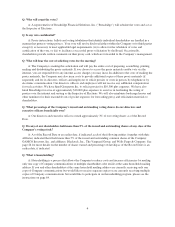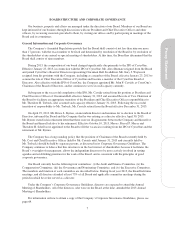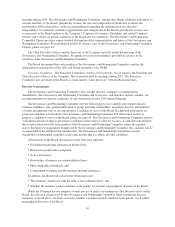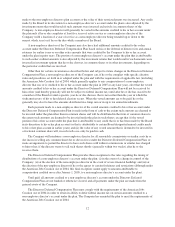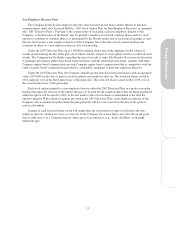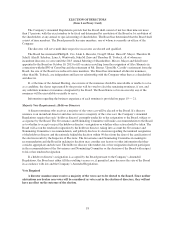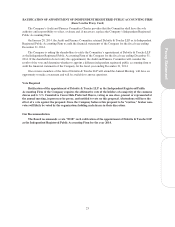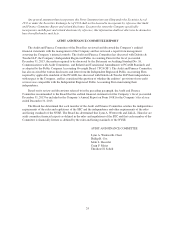Cincinnati Bell 2013 Annual Report Download - page 26
Download and view the complete annual report
Please find page 26 of the 2013 Cincinnati Bell annual report below. You can navigate through the pages in the report by either clicking on the pages listed below, or by using the keyword search tool below to find specific information within the annual report.COMPENSATION COMMITTEE INTERLOCKS AND INSIDER PARTICIPATION
During 2013, the members of the Compensation Committee included Ms. Wentworth, Ms. Haussler and
Messrs. Cox, Maier, and Zrno. None of the Compensation Committee members have at any time been an officer
or employee of the Company. None of the Company’s executive officers serve, or in the past fiscal year served,
as a member of the board of directors or compensation committee of any entity that has one or more executive
officers serving on the Company’s Board or Compensation Committee.
CODE OF BUSINESS CONDUCT AND CODES OF ETHICS
The Company has a Code of Business Conduct applicable to all officers and employees that describes
requirements related to ethical conduct, conflicts of interest and compliance with laws. In addition to the Code of
Business Conduct, the Chief Executive Officer and senior financial officers are subject to the Code of Ethics for
Senior Financial Officers and the directors are subject to the Code of Ethics for Directors.
For information on how to obtain a copy of the Company’s Code of Business Conduct, Code of Ethics for
Senior Financial Officers or Code of Ethics for Directors, please see page 64.
CERTAIN RELATIONSHIPS AND RELATED PARTY TRANSACTIONS
The Board is committed to upholding the highest legal and ethical conduct in fulfilling its responsibilities
and recognizes that related party transactions can present a heightened risk of potential or actual conflicts of
interest. Accordingly, as a general matter, it is the Company’s preference to avoid related party transactions.
Current SEC rules define a related party transaction to include any transaction, arrangement or relationship (i) in
which the Company is a participant, (ii) in which the transaction has an aggregate value greater than $120,000,
and (iii) in which any of the following persons has or will have a direct or indirect interest:
•an executive officer, director or director nominee of the Company;
•any person who is known to be the beneficial owner of more than 5% of the Company’s common shares;
•any person who is an immediate family member (as defined under Item 404 of Regulation S-K) of an
executive officer, director or director nominee or beneficial owner of more than 5% of the Company’s
common shares; or
•any firm, corporation or other entity in which any of the foregoing persons is employed or is a partner or
principal or in a similar position or in which such person, together with any other of the foregoing persons,
has a 5% or greater beneficial ownership interest.
The Company’s Code of Ethics for Senior Financial Officers, the Company’s Code of Ethics for Directors
and the Company’s Code of Business Conduct require directors, officers and all other members of the workforce
to avoid any relationship, influence or activity that would cause or even appear to cause a conflict of interest. The
Company’s Code of Business Conduct, Code of Ethics for Senior Financial Officers and Code of Ethics for
Directors generally require (i) a director to promptly disclose to the Governance and Nominating Committee any
potential or actual conflict of interest involving him or her and (ii) an employee, including the executive officers,
to promptly disclose a conflict of interest to the General Counsel. The Governance and Nominating Committee
(and, if applicable, the General Counsel) determines an appropriate resolution to actual or potential conflicts of
interest on a case-by-case basis. All directors must recuse themselves from any discussion or decision affecting
their personal, business or professional interests.
All related party transactions shall be disclosed in the Company’s applicable filings with the Securities and
Exchange Commission as required under SEC rules. In 2013, there were no related party transactions requiring
disclosure, except as follows: Prior to his appointment to the Board, Mr. Mayer served as an executive officer of
General Electric Co. (“GE”), a significant client of the Company. In evaluating the transaction, the Governance
and Nominating Committee considered the fact that (a) Mr. Mayer had retired from GE prior to his appointment
to the Board and (b) no longer served in any capacity with GE and thus received no direct or indirect material
16


